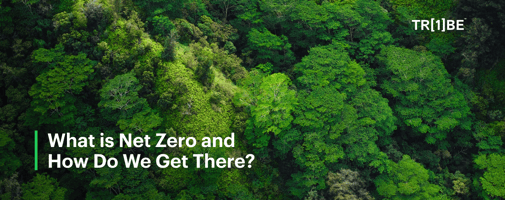Fast fashion is now responsible for more pollution than all international flights and maritime...
Consumer Expectations Towards Decarbonisation And Net Zero

Research data on consumer behaviour in 2022 has shown that many customers are aware of decarbonisation and net zero, but feel business aren’t doing enough to showcase these efforts.
Introduction
75% of UK consumers believe that climate change is a serious problem – 77% of them also believe they have a personal responsibility to do something about it.
If your business isn’t yet offering your consumers a means to protect the planet, then you’re missing out on a huge potential purchase motivator. As more consumers realise the existential threat posed by climate change, the more it will become a key part of the consumer decision-making process.
In this article, we’ll explore what research says about those expectations, as well as how your business can satisfy and appeal to consumers by moving towards net zero.
What Are The Consumer Expectations Towards Climate Change And Net Zero?
Consumers are often clear about the concept of sustainability and green initiatives, but unclear on the details.
According to a report by Catapult Energy Systems, the majority of consumers believe in the threat of climate change and the need for action. But only a smaller number are aware of the main sources of carbon emissions in their day-to-day lives. Research carried out by Deloitte shows that as many as a third of UK consumers are actively searching for businesses with “strong sustainable and ethical credentials.” Deloitte’s study also shows how strong this desire is, with a third of UK consumers now willing to pay more for sustainable products.

Awareness
Interestingly, many consumers are unaware of the need to decarbonise emissions, nor about the 2050 carbon neutrality (net zero) targets.
They know about generic measures including recycling and saving energy, but as a follow up very rarely link sustainability to their household energy consumption for example. However, once targets are explained, most people show a new-found enthusiasm about meeting them. There is definite excitement and empowerment in taking climate action.
Alongside their enthusiasm, customers still remain realistic. Some customers are unconvinced that net zero targets are achievable, while most are concerned about what sustainable changes would mean for their lifestyles.
Questions consumers want answered about climate change:
- How are we going to save the planet?
- What does it mean for me?
- What methods of change are needed?
- How easy are these changes going to be to maintain over time?
- Are these changes genuinely ‘green’ or do they have environmental impacts of their own?
Responsibility
Unlike businesses, consumers do not feel the responsibility to reach net zero emissions lies on them, although some recognise that they will need to play some part in doing so. Most consumers believe the responsibility sits mainly with the government and energy companies. Their belief is that these governing bodies play a much bigger role in making change happen—but they do not always trust that either will do so responsibly.
Many consumers feel that they are already doing their bit for the environment. Generally, through recycling or reducing plastic waste, but in their day-to-day lives, they are not explicitly thinking about how their behaviour impacts the environment. When it comes to changing the way they use energy, they are unsure what steps they should take. They also worry about other people (and nations) not pulling their weight and worry that any significant changes they make themselves are ultimately a waste of time.
Taking Action
Despite acknowledging the need for change in their own lives, for some consumers decarbonisation is confusing and is not a high enough priority for them to make behavioural changes. The biggest concern consumers have is how much any changes would cost them financially. Many feel they are unlikely to make changes to their current energy supply or system without support or guidance.
Overall, whilst most people are supportive of net zero targets and are aware things need to change in order to prevent further climate change, they are put off by the impact that decarbonising might have on their own lives in the short term.
So, consumers are sure they want sustainability and climate action, but they’re not always sure what that looks like. That’s why a truly eco-conscious company should work not only to satisfy these consumer expectations, but also engage them through education. The good news is that the more education businesses can share, the more they will be able to expand their reach into the eco-conscious consumer market.
However, before you start educating, you’ll need to start acting.

How To Meet Consumer Expectations Around Climate Change, Decarbonisation And Net Zero
The best way to both help the environment and meet consumer expectations is to begin the path to net zero. There are plenty of ways businesses can reduce carbon emissions, but to reach net zero emissions, a long-term, substantial plan is needed. For larger businesses, eradicating emissions completely can be a difficult feat. Many will need to rely on carbon offsets (the process of directly removing carbon from the atmosphere) in order to meet sustainability expectations. While this may sound like an advanced tactic, businesses of any size can contribute to reducing global emissions by building this into their practice.
Organisations like One Tribe can help businesses take effective climate action. By simply donating a small portion of sales to carbon reduction efforts, businesses can track the environmental impact of those contributions and share them with consumers. The same goes for B2B or B2C service providers who want to contribute a part of their revenue toward carbon reduction efforts. Of course, if you run a larger business or one with fewer transactions, you can purchase carbon credits that provide a “lump sum” style of carbon reduction, which can be factored against a business’ total carbon output for a given year.
Find Special Ways To Showcase Your Efforts
While it may seem less noble to boast, it is important to show consumers how you have committed your business to help fight climate change. In fact, some even say they need to feel businesses are doing their part before they themselves can commit to taking climate action. Although this can be frustrating, it’s a collective issue that requires moral leadership from the business community.
The good news is that showcasing these efforts is a natural by-product of proper tracking. It can help you give consumers a sense of purpose when purchasing from your business. By helping consumers understand that their payments go to ethical companies and products, you’re also helping them recognise their positive contribution to the economy. So, to that end, every purchase counts.
Climate impact pages
So, how should you demonstrate to consumers the positive actions you are taking? One great method is tracking your progress in real-time . One Tribe partners like Boult Wade Tennant, a patent law firm, use a custom climate action page to show consumers how many trees they’ve planted or protected (which, by the way, is a stunning 594,885!) among other relevant statistics. Adding a sustainability page to your website is a great way to show customers how you are choosing to take climate action and why it’s important to you and your business.

Real-Time Statistics
Another business taking positive climate actions is the fashion brand Koi Footwear, whose climate action page shows they’ve removed enough carbon to equal the emissions of 26,836 cars. These statistics are impressive, verifiable and can be reflected on your website, in-storeand across all online and offline channels as a way to motivate customers and prospects. Using climate action statistics is not only a great way to measure your own progress, but it also helps customers to understand your journey to net zero in a much simpler way. For more on how to market sustainable products or practices, check out our online blog.

Educational Social Posts
Many businesses have taken to social media to market their products or services. But most are still unsure how to effectively engage their target audience on such a diverse and expansive platform. When it comes to talking about climate change and decarbonisation, education is key.
A lack of knowledge about climate change, decarbonisation and net zero has made it very difficult for consumers to understand how businesses are overcoming climate change. That’s why it’s important brands utilise their social platforms to share the highs and lows of their journey to net zero.
Most importantly, brands need to raise awareness and educate their audiences on why they’re reducing emissions and making net zero pledges. Creative campaigns, event days, and even a simple social post can go a long way in helping your customers wrap their heads around the importance of taking climate action.
Summary
It’s up to businesses not only to deliver on these expectations by taking steps to reduce carbon emissions and reach net zero, but to show consumers how and why that matters. Not only can you get the “extra credit” of consumer preference, but you can create a better, more eco-friendly economy in the process. The steps you take may inspire consumers to do the same, and that’s the real point of it all: Taking better care of the environment and ensuring our planet’s future.


